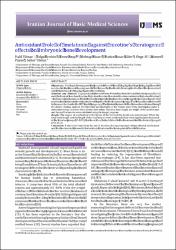Antioxidant role of melatonin against nicotine's teratogenic effects on embryonic bone development

Göster/
Erişim
info:eu-repo/semantics/openAccessTarih
2018Yazar
Yılmaz, HalilErtekin, Tolga
Atay, Emre
Nisari, Mehtap
Susar Güler, Hatice
Al, Özge
Payas, Ahmet
Yılmaz, Seher
Üst veri
Tüm öğe kaydını gösterÖzet
Objective(s): This study investigated the possible effects of low (3 mg/kg) and high (6 mg/kg) doses of nicotine on the skeletal development of rat fetuses by the double staining method and the protective role of melatonin (10 mg/kg) against these effects. Materials and Methods: Eighteen adult female Wistar-Albino rats were divided into six groups (n=3, each) as control, low-dose nicotine, high-dose nicotine, low-dose nicotine+melatonin, high-dose nicotine + melatonin and melatonin. While nicotine was given to the experimental groups on gestation days 1-20, nicotine and melatonin were administered together to the treatment groups. The fetuses were delivered by cesarean section on the 20th day of pregnancy. The skeletal systems of the fetuses were stained using the double staining method. The forelimbs and hindlimbs of the fetuses were firstly investigated under a stereomicroscope, and then their photos were taken. The total bone length, the length of the ossified part and the ossification rate were calculated using the Image) program. Results: The degree of ossification in the bones of the feet and the hands was determined. When the total bone length and the length of the ossified part were evaluated, they were significantly decreased in the nicotine groups (P<0.05), but were close to each other in the treatment and the control groups (P<0.05). Conclusion: It has been found that the use of nicotine during pregnancy delays skeletal ossification and that melatonin, a powerful antioxidant, eliminates the teratogenic effects of nicotine.















